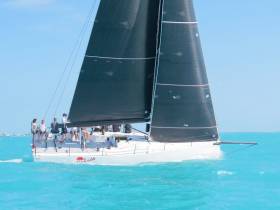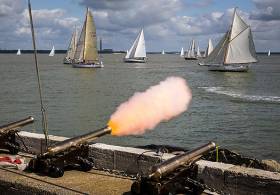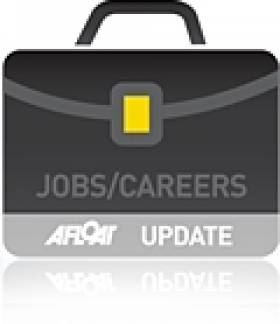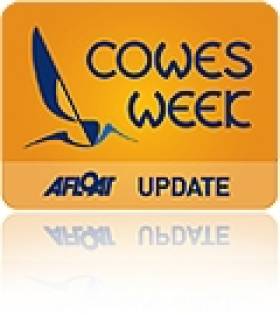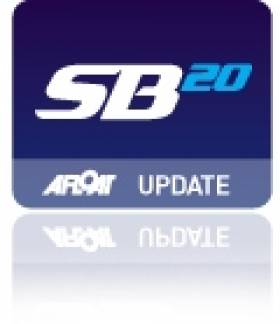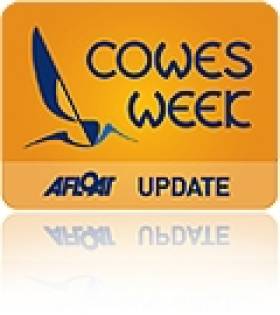Displaying items by tag: Cowes Week
Irish En Route To Crew Tschüss For Cowes Week
#CowesWeek - Maurice O’Connell and three other Irish sailing stalwarts are headed to the Isle of Wight to join the crew of Tschüss, Christian Zugel’s MAT 1180, for Cowes Week.
Navigator Ross Monson, boat captain and pit boss Johnny Mordant, Simon Johnson at bow and mainsheet trimmer O’Connell will be racing one of three MAT 1180s in the 16-boat IRC Zero fleet, alongside Leeloo from the Netherlands and strong debutante Gallivanter.
But they won’t be the only ones to watch out for in a fleet that includes Piet Vroon’s Tonnere, Round the Island winner TP52 Gladiator and last year’s winner, Daniel Hardy’s Ker 46 Lady Mariposa.
Other Irish at Cowes Week from this Saturday 29 July to 5 August include Damian Foxall, the Kerry offshore veteran on deck with Vestas 11th Hour for the Round the Island as part of preparations for the next Volvo Ocean Race.
Cowes United: A New Race Committee Boat for Cowes
The official launch of Cowes United, a brand new Committee Boat for Cowes, took place on 13th May on Trinity Landing opposite the Royal London Yacht Club. Ben Rouse, High Sheriff of the Island, made an amusing speech and dedication. a post on the cowes Yacht Haven Facebook page gives details about how the new Committee Vessel came about.
This purpose-built catamaran is a state-of-the art Committee Boat, and is fully equipped to a very high standard; it is made available by the generosity of David & Patsy Franks. David's speech disclosed his dream that Ben Ainslie representing Britain and the Royal Yacht Squadron would bring the cup home and then select this new boat as the Committee Boat for the 2019 competition in the Solent. The six clubs which together form Cowes Combined Clubs (Royal London, Royal Ocean Racing Club, Royal Thames, Royal Yacht Squadron, Island Sailing Club and Cowes Corinthian) have already booked the boat for some of their racing this season.
It will be used at many major events including Cowes Week, Charles Stanley Direct Cowes Classic Week, IRC Nationals, Telegraph Bowl, Silicon Cup, and Royal Thames Etchells Invitational for the Gertrude Cup.
The boat is supported by help from the Cowes Harbour Commissioners. Joliffes Chandlery in Cowes, B&G and Spinlock have been particularly generous as sponsors. Cowes United will be used for many youth sailing events supported by Cowes Yacht Haven and Red Funnel, who have both been very generous in their support.
Graham Sunderland of Winning Tides fame has masterfully navigated the project through to completion making over 35 modifications, and ably assisted by Kevin Downer and Steve Coles. Bob Milner's experienced eye and contributions from Stuart Childerley, Peter Taylor and Cowes Week Director Phil Hagen have also been very significant in achieving the success of this project.
Cowes United is available to all clubs which use the Solent, for racing and for corporate events.
Triple Crown Big Boat Event Announced For Cowes Week 2017
Cowes Week, organisers of one of the world's best-known sailing regattas, have announced the introduction of a new big boat race series, the Cowes Week Triple Crown.
The new Cowes Week Triple Crown will be a regatta within a regatta: open to large IRC rated racing boats of at least 20m LOA with a minimum TCC of 1.500 and up to 36m LOA. A series of three races will take place on the Tuesday, Wednesday and Thursday of Cowes Week, with the final race being an Around the Island Race, giving participating boats the opportunity to mount record-breaking circumnavigation attempts.
With a potentially wide range of boats expected to enter, from out-and-out racing boats to cruiser-racers, three classes will compete for the Triple Crown: Maxi-Racer Class; Cruiser-Racer Class and an Ocean-Racer Class.
Three of the sailing world's most historic and prestigious trophies will be awarded to the three classes:
- The Queen's Cup, presented to the Royal Southampton Yacht Club by Queen Victoria in 1897;
- The King George V International Cup (also known as the White Heather Cup) from the Royal Thames Yacht Club, a huge flagon that was awarded for the 23 metre class in 1911 and won by White Heather II
- Royal Yacht Squadron's King's Cup 1920 which was presented by King George V in 1920 for a race for yachts exceeding 100 tons.
The overall winner of the three races will be presented with the Triple Crown trophy. The innovative Triple Crown idea may attract similar competitions in Ireland where there is an array of ancient trophies available for repurposing.
Katsu Best Of Irish As Teasing Machine Wins RORC Ushant Race
#Offshore - Alan Hannon’s Reichel-Pugh 45 Katsu has emerged best of the three Irish entrants at fifth overall in the 400-mile RORC Cowes-Wolf Rock-Ile d’Ouessant (Ushant)-St Malo Race, which started on Sunday 14 August in the Solent to round out Cowes Week 2016, and experienced a wide range of speeds for the diverse fleet of 45 boats, writes W M Nixon.
Line honours at the French port of St Malo, with its famous fortified harbour, were taken late on Monday afternoon by the MOD 70 trimaran Phaedo 3 (Lloyd Thornburg), with the current Round Ireland record holder managing to stay ahead of sister ship Concise (Ned Collier Wakefield).
But while the big trimarans were comfortably finished after only one night at sea, the easterly breeze was fading and the smaller tail-enders – including the 1976 Half Ton (when Harold Cudmore-skippered) World Champion Silver Shamrock (Stuart Greenfield) – were only finishing today, with the famous Shamrock finally crossing the line at 9:05 this morning, thereby ending up with four nights at sea before they could relax in hospitable St Malo.
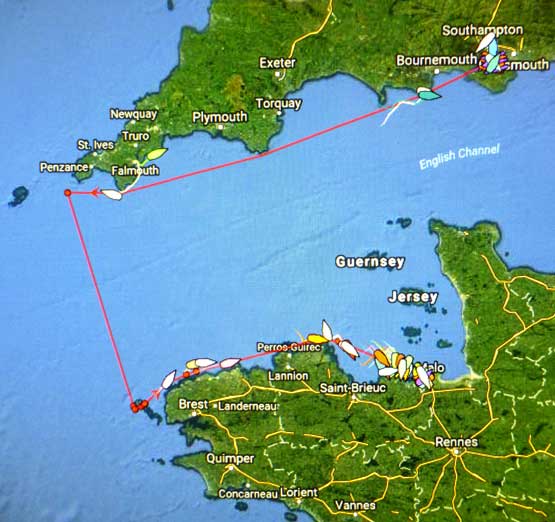 So near and yet so far: the main part of the RORC fleet crowded on the race tracker in light airs off St Malo at 1830 yesterday evening as they struggled to finish the 400-mile race from Cowes via Wolf Rock and Ouessant
So near and yet so far: the main part of the RORC fleet crowded on the race tracker in light airs off St Malo at 1830 yesterday evening as they struggled to finish the 400-mile race from Cowes via Wolf Rock and Ouessant
The vintage Swan 37 Xara (Jonathan Rolls), which had been overall leader at lunchtime Tuesday when she’d been down off Ouessant, finally completed at 3:24 this morning to register 22nd overall, while Silver Shamrock was 24th.
As expected here yesterday, it was Eric de Turckheim’s wonderful A13 Teasing Machine that won overall by a margin of 3 hours and 20 minutes from the German Ker 46 Shakti, a result which, when combined with her second overall in the Volvo Round Ireland back in June, will be making the Machine a challenger for the RORC Points Championship.
It was a good race for northerner Alan Hannon, as Katsu was fifth overall and by taking second in Class 1 astern of Teasing Machine, she was one place better than the First 44.7 Lisa which, under Michael Boyd’s command, was one place ahead of her in the Round Ireland.
Michael Boyd, Commodore of the RORC, was meanwhile racing his new JPK 10.80 Audrey round Ushant, and in a private battle with the third Irish entry, Conor Fogerty’s Sunfast 3600 Bam!, Audrey was to have it by just 20 minutes to make them 9th and 11th overall respectively, while their placings in IRC 3 were 3rd and 4th.
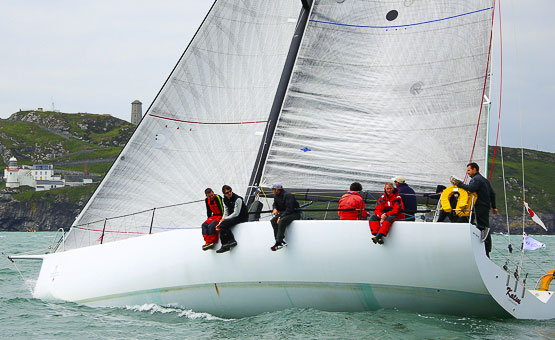 Alan Hannon’s RP 45 Katsu shortly after the start of the Volvo Round Ireland Race at Wicklow in June, when she finished 4th overall
Alan Hannon’s RP 45 Katsu shortly after the start of the Volvo Round Ireland Race at Wicklow in June, when she finished 4th overall
Cowes Week Sponsor Stays Onboard For Another Year
Cowes Week, one of the UK's longest running and most successful sporting events, has been given a boost this week with the announcement that Aberdeen Asset Management has agreed to support the sailing regatta for one more year in 2016 - adding a final chapter to their Cowes Week story.
Aberdeen's original five year title sponsorship commitment of Cowes Week came to end after the 2015 regatta. The support offered to Cowes Week Limited from Aberdeen Asset Management can be seen as a sign of Aberdeen's desire to ensure the 2016 instalment of Cowes Week is just as successful as previous years.
Cowes Week, which is looking to secure a new title sponsor for 2017 and beyond, has evolved enormously since its beginning in 1826 and now has between 800 and 1,000 boats competing in up to forty different classes in early August each year. Around 8,000 competitors now participate, ranging from Olympic yachtsmen to weekend sailors, and the event attracts over 100,000 visitors to Cowes for what is one of the highlights of the British social and sporting calendar.
Along with Aberdeen Asset Management, local businesses, yacht clubs and supporting sponsors have worked together with Cowes Week Limited to guarantee the success of this year's regatta and to help the event attract a new sponsor from 2017 onwards. Racing will be as exciting and competitive as ever, and there will be a buzzing shoreside scene for both competitors and visitors to enjoy.
New Regatta Director Appointed For Cowes Week
Phil Hagen has been appointed Regatta Director of Cowes Week. Phil takes the reins from Stuart Quarrie, who retired following this year's regatta in August.
Phil is no stranger to Cowes Week, having started as a course setter 11 years ago. After four years he progressed to Course-Setting Coordinator, responsible for the planning and management of the course setting and race progress teams. Phil is an experienced yacht racer and has competed in many European events in a wide range of yachts including helming in the 6 metre and Farr 45 classes and race navigation on a 135ft Classic.
Phil is also a qualified race officer and has run a number of national championships in the Solent. In 1998, as Project Director, he was responsible for the planning, PR and operational delivery of the Cable & Wireless Adventurer, a successful round the world record attempt by a motor vessel. The success and record of 72 days still hold today.
Phil will join the team in early October and replaces Stuart Quarrie who, after seventeen years with CWL, has departed to spend more time racing and cruising with his family.
Cowes Week Ltd Seeks New Sailing Director
#Cowesweek – The organisers of the world famous Aberdeen Asset Management Cowes Week regatta are seeking a new Sailing Director to replace Stuart Quarrie, who will retire following this year's regatta in August.
The Sailing Director role is a full time post, and carries a responsibility to retain and further develop Cowes Week's position as a "must-do" regatta on the global sailing calendar. The organisers are looking for someone who is well-known on the yachting and racing circuit, has the vision to take the regatta forward and can work with existing and potential entrants, class associations and organising clubs to ensure the event offers the best possible racing experience.
The new Sailing Director will work as part of a small executive team and also with the member clubs of Cowes Combined Clubs through the regatta's Sailing Committee. An attractive package is available to the right person, with a salary of c£50k, depending on experience. The closing date for applications is 7th April 2015 and it is anticipated that interviews will be held during the week commencing 20th April. The successful candidate will start in July 2015, gaining some experience of this year's regatta, before taking over from Stuart in August.
Anyone interested in the role should request further details from Peter Dickson, Chairman of CWL, at [email protected]
Royal Navy Man Found Guilty Over Cowes Week Yacht Crash
#YachtCrash - A former serving lieutenant in the Royal Navy has been found guilty of breaching international maritime law and ordered to pay more than £100,000 (€117,000) in fines and costs over an incident during Cowes Week 2011.
According to Practical Boat Owner, the court in Southampton today (25 October)ruled that Roland Wilson had broken three Colregs (Convention on the International Regulations for Preventing Collisions at Sea) when his Corby 33 yacht Atalanta of Chester crashed into an oil tanker in the Solent on 6 August 2011.
It was ruled that Wilson 'did not keep an adequate lookout' (rule 5) when he sailed his yacht into the exclusion zone reserved for shipping traffic during the Cowes Week festival, then 'impeded a large vessel in a narrow channel' (rule 9b) and 'impeded a vessel constrained by his draft' (rule 18) as the tanker bore down on him and his vessel.
The court heard that a crew member on the eight-man yacht jumped overboard moments before the collision with the front of the tanker.
In the moments that followed the yacht's rigging became tangled on the tanker's anchor which collapsed the mast onto another crew member who was later hospitalised but not seriously hurt.
BBC News reports remarks from District Judge Anthony Callaway in passing sentence, saying: "Fortuitous it was that there was no loss of life. The potential for even greater and tragic consequence is, in my judgement, apparent.
"This was a serious yacht crewed by serious people in a regatta for a serious purpose. It was well equipped in terms of experience and ability to deal with any situation.
"This was not some Saturday afternoon jaunt by some inadequate vessel crewed by inexperienced, clueless and foolhardy people who frankly have no business being on the water at all.
"The yacht took a decision, and as I find the wrong decision, to sail towards the problem into the path of the tanker across a narrow channel. It should have kept clear and in the worst event used her engine."
Just Launched SB20 Wins Inaugural UK Grand Slam at Cowes Week
#sb20 – With an eye to the form book for the SB20 World Championships in Hyeres next month, SportsboatWorld.com won the inaugural SB20 UK Grand Slam on day four of Aberdeen Asset Management Cowes Week. Jerry Hill, Craig 'Spike' Watson and Richard Lovering sailed an excellent series in a brand new SB20 which was only launched on Thursday 1st August.
Without completing the final two races of the event, just one discard was applied to the six results generated over the previous three race days. After the discard Jerry Hill and Joe Lewellyn were tied on 8 points, but Hill took the Grand Slam title and lifted the Sportsboat World Trophy on count back
The SB20 class now looks towards the 2013 World Championships, in early September in Hyeres, south of France. 100 boats are expected to compete in the Championship, with 14 irish entries.
Cowes Week Ladies Day & Offshore Sailing Action Video
#cowesweek – Highlights of Ladies Day and the Artemis Challenge with some of the world's best offshore sailors in action with a number of British celebrities on board. Damian Foxall's Oman team was in action with Oman Sail's stars of the future given the chance to compare notes with two future celebrities from Britain's sailing programme when they joined forces on Oman Air-Musandam for the Artemis Challenge in Cowes today.
RYA Youth SL16 sailors James Henson, 18, and Olivier Greber, 17, were put to work on the winches under the expert eye of French skipper Sidney Gavignet who has been responsible for Oman's flagship MOD70 and for the development of some of Oman's best young sailors for the best part of three years including Fahad Al Hasni and Ahmed Al Hasni.
His training team was boosted by British yachtswoman Dee Caffari whose guidance was welcomed by Henson and Greber as well as her own young charge Raiya Al Habsi, who on Sunday becomes the first Omani woman to take part in the Rolex Fastnet Race as part of the Oman Air-Musandam team.
"They asked a lot of questions about Fahad and Ahmed like how old they were and how they got to sail on the MOD70," Dee said.
"Ahmed who used to race F18s comes from a similar background to them and he is a much more intuitive sailor and his development has been quick. Their backgrounds are conducive to fast development and I think they had a glimpse of what is possible for the future."
The young British pair, who recently won a silver medal at the 2013 SL16 World Championships at the Cercle de la Voile du Pyla sur Mer in France were blown away by their day on Oman Air-Musandam and full of envy that the young Omanis get to experience such a high performance boat so early in their careers.
"It was an awesome experience," said James. "It was impressive that Ahmed who is the same age as us is extremely lucky enough to be racing on a boat like that. It was a great honour for us – we felt honoured just to be involved today so it is a fantastic opportunity for him."
Olympic gold medallist Paul Goodison, a product of the RYA Youth programme, was impressed with the young Omani team and how quickly they had learned the ropes. "We had trimmers each side – me one side and Fahad portside," he explained.
"We were sailing upwind and set up the jib how we thought it should be set up but I was really impressed when I went to the other side and saw the trim was similar to mine. We were either both getting it right or both getting it wrong."
For Raiya, it was her first time competing on the MOD70 and the experience gave her a sense of the power and pace of Oman Air-Musandam in full race mode. Happily she was undeterred and keener than ever to get her first offshore race on the MOD70 underway.
"It was good fun," she said. "I was on the traveler and am keen to do more although I wouldn't be much good at grinding. It gave me a taste of what to expect in the Fastnet and I think it will be a great experience for me and really good for my learning curve."
The partnership between British and Omani youth was one that proved interesting for Gavignet who while helming the boat round the 50 nautical mile course around the Isle of Wight enjoyed seeing them all comparing notes.
"It was very interesting to have all these talented young sailors on board especially the similarities between Ahmed, James and Ollie who are similar ages and backgrounds," he said.
Oman Air-Musandam were handed a 30 minute penalty after they were found to be over the line at the start and despite finishing the course 11 minutes behind Groupe Edmond de Rothschild who took line honours, the penalty placed them in eighth place.


























